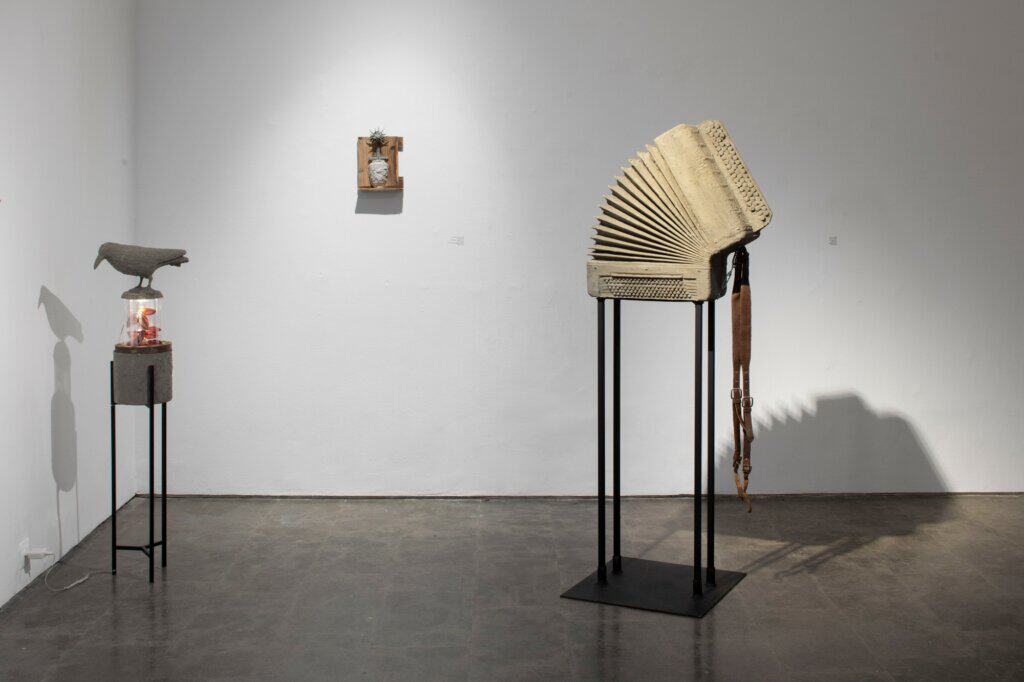Michal Shachnai: On the Cypress Spear
Curator: Anat Gatenio
21/06/2024 -
04/01/2025

”Even an old landscape has a moment of birth,” wrote Natan Alterman in his poem ”Moon,” a line from which gave its name to this exhibition.* In Michal Shachnai׳s (b. 1967) works presented in it, familiar images, culled from her immediate surroundings, which carry the DNA of ”Israeliness,” are reborn: an accordion, a barbecue grill, an inner tube, a water tower, a shovel, a canteen, etc. From these iconic, local objects, which originate in different areas of our collective memory, she constructs unexpected jigsaw puzzles that propose a new reading.
A parallel world of images woven into the works alludes to archetypal rituals of other cultures from different places and times (totem, caryatids, aura, wings, raven), shedding light on the ritual-ideological aspect of the Zionist and kibbutz rituals. The sculptural objects are arranged in structures reminiscent of an altar, a totem, or a religious icon, in an improvised language that undermines their sacred status. While this display indeed strengthens their status as holy relics, their ritualism is deconstructed in an envelope of ridicule and humor.
The hybrid quality of Shachnai׳s work is also manifested in the choice of sculpting materials and the unraveled appearance of the objects. She ”embalms” readymade objects in concrete (the material associated with commemorative sculpture and Zionist-Israeli modernism), and decorates them with gold leaves and colored plastic, which are an antithesis to the heavy, rough, and frugal material language.
The collage principle is also characteristic of the lyrical screen works in the exhibition. Ceremonial fragments of agricultural and other Israeli rituals were collected from archives or from documentation on the web, decontextalized and emptied of their content. They were assimilated into new, poetic compositions, which delve into the mythological aspect of the settlement ritual tradition.
The featured works range from blown up to scaled down, from the weightiness of sculptural monuments to the lightness of miniature objects. A similar oscillation also characterizes the structure of the exhibition, whose trajectory goes from the open public space to a quasi- domestic installation hidden behind walls.
Shachnai׳s hybrids eliminate all hierarchy, evoking contrasting feelings of familiarity and foreignness, irony and pain. As an artist whose work was nourished by her childhood in a Jezreel Valley kibbutz, and being a bereaved daughter, the ideological world of the ”tribe” that filled her world collapsed, leaving an emptiness behind. The ideological frameworks were privatized and disappeared, and the ceremonies remained empty of content. In her work Shachnai articulates the disintegrating pathos, but also the yearning for significant values which transcend the self.
The works on view were created in the last four years. Today, following October 7th and the return of the kibbutzim to the public agenda as significant places of residence distinguished by communal sturdiness, the view of the works and the contents underlying the exhibition has also expanded.
* Natan Alterman, ”Moon,” in Selected Poems: Bilingual Edition, trans. Robert Friend (Tel Aviv: Hakibbutz Hameuchad, 1978), p. 15.



Installation photographs: Tal Nisim

